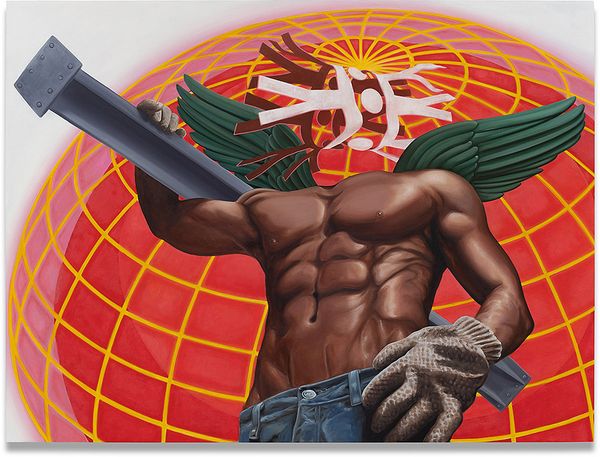Lucia Love, "Gigantic",2021.
LUCIA LOVE
Tell us about your work in the show: what was your inspiration and why did you select it to be included?
"Gigantic" is from my current series exploring ways to reimagine how angels are depicted, and what cultural function they perform in an ethnically diverse, increasingly secularized, networked reality. Angels still exist in popular imagination to foster allegory, but my understanding of them has been crafted in large part by the western art canon. Reconstructing these figures has given me the chance to question the underlying structure that informs our presuppositions about how and why things can appear as they do. I was excited to include this particular piece because of how intriguing it is to be exploring gender in conjunction with these mythological themes.
Who is a woman that has deeply inspired you?
I'd have to say the artist Emily Mae Smith has made a profound impact on the way I conceive of my artistic identity. Her fearless way of fusing history and style with a centered politics continues to be an inspiration.

Nadia Waheed, Chantico, 2021.
NADIA WAHEED
What are some of the challenges facing an emerging female contemporary artist today? And how do you personally approach solving them?
From the outside, the art world is performing a lot of “growth” and “unlearning” of racist and misogynistic values and perspectives. Indeed, real and sincere efforts are being made to change and uplift voices that have historically been oppressed — however on a regular basis there are clear indications that while efforts are being made for the correct “actions” to be made, the fundamental value system of those in power, in my opinion, so far remains the same. Racism still exists, women and POC are still seen to be intellectually inferior, minorities are still being used as cogs in a machine built to primarily benefit the elite ruling class. So as to the question of the challenges — I believe the challenges are the same as they have always been, as every time I walk into a room or open my mouth to speak, I am first tasked with proving that I’m even worth paying attention to. My accomplishments from day one have been taken away from me, explained as “trend” and my race brought up as “good marketability”.
The biggest challenge I face, one that I doubt I will ever escape, is that I am not seen as a dimensional person, only as a “Brown” “Woman”. It has taken me a lot of time to release my bitterness at the lazy flattening of my entire life and identity into two tiny words, and I haven’t fully released it all, but my primary response, as it always has been, has been to bow my head and work. Let them say what they will say, let them insult my intelligence or career, let them do whatever they want; I will continue to work, I will continue to grow, change, evolve into something better, stronger. If I have no respect or validation, it doesn’t effect my actions, I was put on this earth to do exactly what I’m doing now, to make paintings. The opinions of others will never change that.
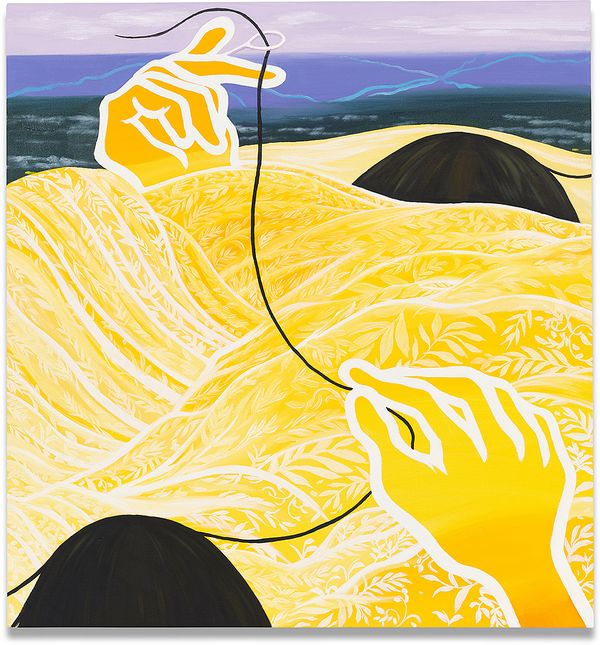
Hiejin Yoo, You Can Protect My Dream, 2021.
HIEJIN YOO
Tell us about your work in the show: what was your inspiration and why did you select it to be included?
My paintings are an intimate journal and meditations on self-discovery. They grow from journal entries and the world around me. I keep a brief diary of daily life, and it is the everyday, mundane things that inspire me most.
I got inspired as soon as I heard the title of the show.
I remembered I had a dream that I was in the middle of a flower field (our bed cover has a flower pattern as well) and my husband was trying to find me. I often talk to him when he needs to find me, even in my dream. We always think about each other as a needle and a thread.
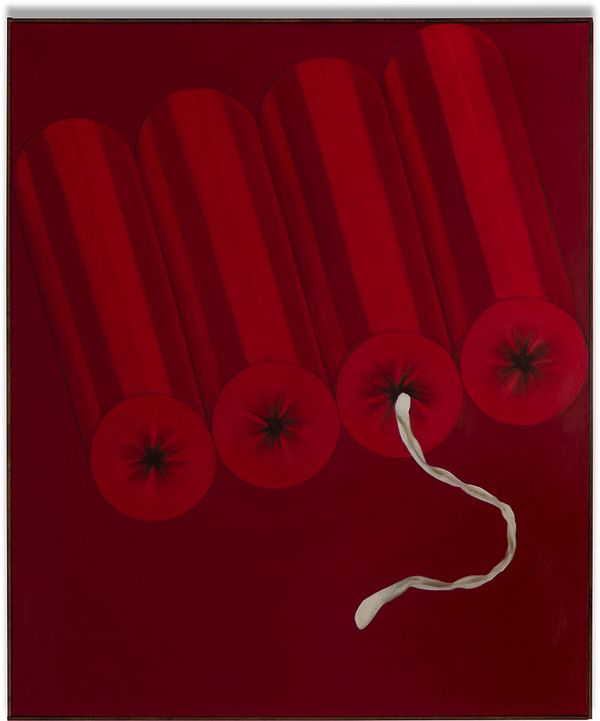
Emily Furr, Dynamite Row, 2021.
EMILY FURR
How does your work respond to the show’s themes of contemporary society, identity, gender, cultural history or dynamics of power?
My work seeks to restore the feminine archetype and usher in a new yonic era. I try to disassemble patriarchal symbols to show the female aspect overcoming the phallocentrism of the current moment. I explore binary oppositions, such as masculine versus feminine, while exploring the potentialities and limitations of scale.
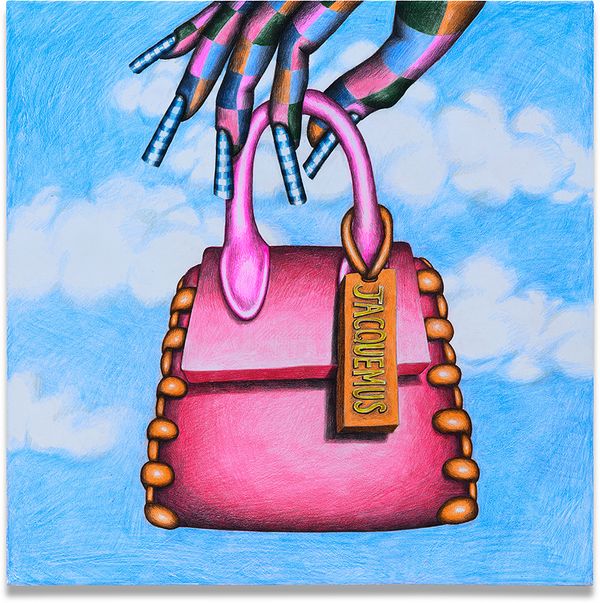
Samantha Rosenwald, Micromanager, 2021.
SAMANTHA ROSENWALD
What are some of the challenges facing an emerging female contemporary artist today? And how do you personally approach solving them?
I have been told by several of my male counterparts that I’m gaining attention in the art world because “being a female artist is in right now.” While saying that, especially to my face, is offensive in many ways, the sentiment is definitely a popular one. I’ve found that I need to work twice as hard as a male artist to not only prove my worth, but to prove that my very existence isn’t a fad or a gimmick.
How does your work respond to the show’s themes of contemporary society, identity, gender, cultural history or dynamics of power?
Woman has always been cast as the role of the object, as opposed to the subject — life relentlessly inflicts itself onto her. The female body is treated as a screen onto which society projects its mores and desires. She is what we want her to be. In my work, the garish little purse informs the whole composition. The plastic spindly female hand gently holding the purse becomes the purse — becomes the object of lust. The colorful hand and the colorful bag become one as an inhuman vessel (literally and figuratively) of seduction and desire.
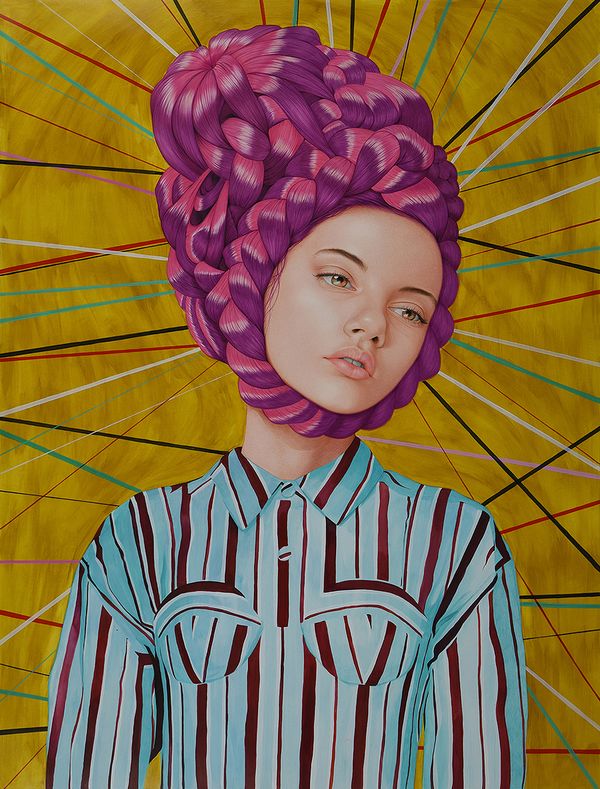
Ángeles Agrela, Olimpia, 2021.
ÁNGELES AGRELA
How does your work respond to the show’s themes of contemporary society, identity, gender, cultural history or dynamics of power?
My work re-elaborates historically repeated female archetypes, which are perpetuated mostly by men. The starting point is feminist and cannot be otherwise. I appropriate the traditional techniques of drawing and painting and use them as a tool. I wonder if our ability to build our own image, both to show ourselves to others and to camouflage ourselves within the herd, is still imposed on us by a system that controls or empowers us. I try to play in a subtle way with the notion of the tragicomic in a contemporary society that is at once civilized, sophisticated and ridiculous. I use the symbolic and communicative charge of hair a lot to create masses that often replace the face or hide it completely, sometimes as an emblem of strength and independence, and sometimes as an instrument of restriction, silencing, blinding or suffocation.
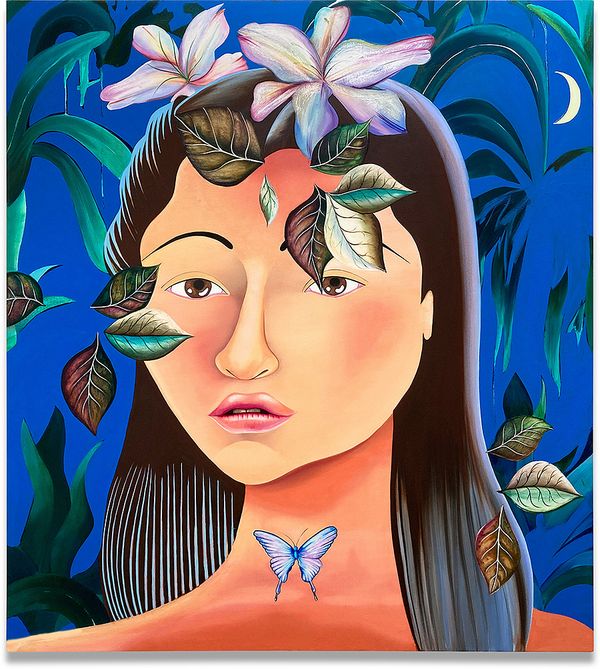
Marcela Flórido, Tapajos, 2021.
MARCELA FLÓRIDO
Tell us about your work in the show. What was your inspiration, and why did you select it to be included?
My painting, "Tapajós," is part of a new series in which I try to embrace the convention of self-portraiture. Questions of identity and self-representation have always been an aspect of my work but have never been core to it. In the past year, however, I have been intensely exploring these questions through paintings that depict the same figure — a fantastical version of myself— in a series of similar but ever-changing compositions.
I chose this particular work because it is a very candid self-representation but is still immersed in symbolism. In the painting, I show 'myself' standing in what seems to be a lush and fantastical underwater forest. The figure gazes outward; her neck is elongated, and a butterfly is awkwardly positioned in the middle of it. With these gestures, I wanted to focus on her throat, which holds our voice, self-expression, speech, and will. The smaller scale and the figure's bust-length depiction draws in the viewer, but, at the same time, the leaves falling in the foreground create distance and separation between the viewer and figure.
There is a slowness to the scene as if it is underwater or obeying the rhythm of the water. In fact, the title "Tapajós" refers to a river in the Amazon Rainforest in Brazil that I visited with my sister right before the pandemic broke out. I was inspired by everything that lived there. I haven't been able to go back to Brazil, where I am from, or see my family during the pandemic, so this work reveals a feeling of longing, of living in an interior landscape. That is perhaps why the painting gives me a feeling of being underwater.
Who is a woman that has deeply inspired you?
Paula Rego's life and work have deeply influenced me. I became acquainted with her paintings while studying at the Slade School of Art in London, the same institution Rego attended in 1952. At the time, I started taking psychoanalytic therapy and was excited by its theory and process, which started influencing my paintings. I learned that Rego had also seen a Jungian analyst in the 1970s. She was creatively blocked and financially broke, floundering in London after moving from her native Portugal. She was making pop art, which was fashionable at the time but wasn't working for her. The therapy awakened a need in her to go to the source, where the images come from. In Jungian terms, the mystical and sacred silent center — the wellspring of archetypal ideas, which form the collective unconscious. It is interesting how much Paula and I have in common, from the Portuguese culture, our London experience, and our dive into psychoanalysis.
Discover More from Sweet Jane in Fields of Daises curated by Joan Tucker>
Recommended Reading
The Women of "Woman to Woman">
Alice Neel at The Met: In Conversation with Curators Kelly Baum and Randall Griffey>
